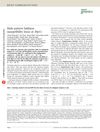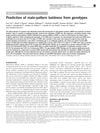A PAX1 Enhancer Locus Is Associated With Susceptibility to Idiopathic Scoliosis in Females
March 2015
in “
Nature Communications
”

TLDR A genetic region near the PAX1 gene is linked to a higher risk of scoliosis in females.
The document presents a study that identified a genetic locus associated with idiopathic scoliosis (IS) in females. Researchers conducted a genome-wide association study (GWAS) involving 3,102 individuals and found significant associations with single-nucleotide polymorphisms (SNPs) at the 20p11.22 locus near the PAX1 gene in females, but not in males. The association was confirmed in independent cohorts from the United States and Japan, with an overall P-value of 2.15 × 10^-10 and an odds ratio of 1.30 for SNP rs6137473. The study also found that the IS risk alleles at this locus had been associated with protection from early-onset alopecia, indicating a potential genetic overlap between IS and androgenetic alopecia (AGA). A sequence within the associated locus was identified as an enhancer in zebrafish muscle and spinal cord, but its activity was disrupted by the IS-associated SNPs. The study suggests that PAX1 may play a role in spinal development and contributes to understanding the sexual dimorphism in IS susceptibility.








